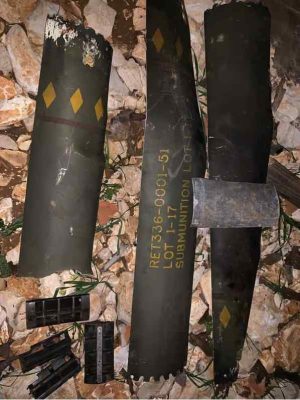
Exclusive: Images are the first indication in almost 20 years that Israel used cluster munitions.
Photos of munitions debris in southern Lebanon, seen by The Guardian, suggest that Israel used widely banned cluster munitions in its recent 13-month war in Lebanon.
The images, which were examined by six different weapons experts, appear to show the remains of two different types of Israeli cluster munitions found in three separate locations: south of the Litani River, in the wooded valleys of Wadi Zibqin, Wadi Barghouz and Wadi Deir Siryan.
Remains of what is believed to be a Barak Eitan-type fragmentation munition, with the word “fragmentation” written in Hebrew on the projectile.
The evidence represents the first indication that Israel used cluster munitions in almost two decades, since it used them in the war in Lebanon in 2006. It would also be the first time that Israel is aware of the use, by Israel, of the two new types of cluster munitions found: the 155 mm M999 Barak Eitan and 227 mm Ra’am Eitan guided missiles.
Cluster munitions are bombs in containers that release many smaller submunitions, small “bomblets”, over a large area, equivalent to several football fields. The use of cluster munitions is largely prohibited, as up to 40% of submunitions do not explode on impact, posing a danger to civilians who may later encounter them and be killed when they explode.
To date, 124 states have joined the convention on cluster munitions, which prohibits their use, production and transfer. Israel is not a signatory to the convention and is not bound by it.
“We believe that the use of cluster munitions always conflicts with the armed forces’ duty to respect international humanitarian law, due to their indiscriminate nature at the time of use and thereafter,” said Tamar Gabelnick, director of the Coalition Against Cluster Munitions. “Their wide impact means they cannot distinguish between military and civilian targets, and residue from cluster munitions kills and maims civilians for decades after use.”
The Israeli Armed Forces neither confirmed nor denied the use of cluster munitions, but stated that they “use only legal weapons, in accordance with international law and minimizing harm to civilians.”
Israel’s war against Hezbollah, which began in October 2023 and killed nearly 4,000 people in Lebanon and around 120 in Israel, has devastated the Lebanese militant group. Much of southern Lebanon remains in ruins and Israel still carries out almost daily airstrikes on the country despite a ceasefire signed last year.
Lebanon, in particular, has a painful history with cluster munitions. Israel bombarded Lebanon with 4 million cluster bombs in the final days of the 2006 war, around 1 million of which failed to explode. The presence of unexploded cluster bombs continues to make life in southern Lebanon dangerous, with more than 400 people killed by unexploded submunitions since 2006.
The large number of unexploded cluster bombs in Lebanon was one of the main factors driving the drafting of the cluster bomb convention in 2008.
Despite not being a signatory to the convention, Israeli officials have condemned Iran’s use of cluster munitions in Israel during this summer’s 12-day war. “The terrorist regime seeks to harm civilians and has even used weapons with wide dispersion to maximize the scope of damage,” Israeli military spokeswoman Brigadier General Effie Defrin said following an Iranian cluster munition attack on populated areas in southern Israel.
Images of the remains of the first cluster munition, a 155mm M999 Barak Eitan advanced anti-personnel munition produced by defense company Elbit Systems in 2019, were verified by six weapons experts, including Brian Castner, head of crisis research at Amnesty International, and NR Jenzen-Jones, director of Armament Research Services, a technical intelligence consultancy specializing in weapons and ammunition analysis. Elbit Systems did not respond to a request for comment.
According to a US Army manual on the weapon, each M999 artillery shell releases nine submunitions that explode into 1,200 tungsten fragments.
 The wreckage of the second munition, according to two analysts, was from a Ra’am Eitan guided missile. Yellow diamond-shaped markers indicate that the projectile contains high-explosive submunitions.
The wreckage of the second munition, according to two analysts, was from a Ra’am Eitan guided missile. Yellow diamond-shaped markers indicate that the projectile contains high-explosive submunitions.
Photos of the remains of the second munition were identified as being from a cluster bomb by five different weapons experts, although most were unable to identify the exact model due to a lack of public domain material on this specific rocket.
Jenzen-Jones and an independent weapons analyst said the weapon was a 227mm Ra’am Eitan guided missile, a new type of cluster munition developed by Elbit Systems. This specific projectile was produced in 2017, as evidenced by its batch code.
Israeli media described the Ra’am Eitan as a guided missile that carries 64 submunitions each, which “disperse in a large radius and kill everyone present.” According to an Israel Defense Forces (IDF) press release in February 2024, Israeli troops operating on the country’s northern border were equipped with the Ra’am Eitan in preparation for a confrontation with Hezbollah.
The legality of the use of cluster munitions by non-signatory countries depends on the circumstances of the attacks in which they were used, as well as the intentions of the military personnel involved. The Guardian newspaper does not have information about the attacks in which the projectiles were used, as the wreckage was found later.
The wreckage was found in heavily forested valleys in southern Lebanon, a region that Israel accused Hezbollah of exploiting during the war to protect itself from aerial bombardment and surveillance.
Cluster munitions, due to their wide dispersion, could be useful against soldiers spread across large forested areas. American forces used cluster munitions in a similar manner in Vietnam, covering dense jungles where Viet Cong soldiers were stationed.
According to Israeli media reports, both cluster munitions found were developed in recent years to leave fewer munitions unexploded, with claims that the Ra’am Eitan had a “failure rate” of 0.01%. Israel developed the munitions after the use of cluster bombs in the 2006 Lebanon war sparked international and domestic outrage, seeking a way to continue using cluster bombs while minimizing harm to the civilian population.
Gabelnick and other weapons experts warned that failure rates announced by weapons companies were often much higher in the field. Israel Military Industries claimed a 0.06% failure rate for the M85 cluster munition used in the 2006 war; later analysis suggested the rate was around 10%.
Human rights organizations have stated that it is impossible to use cluster munitions in a way that minimizes harm to civilians.
“Cluster munitions are banned internationally for a reason. They are inherently indiscriminate and there is no way to use them legally or responsibly, and civilians are most at risk, as these weapons remain lethal for decades,” Castner said.
Originally published by The Guardian on 11/19/2025
By William Christou
Source: https://www.ocafezinho.com/2025/11/20/fotos-de-fragmentos-sugerem-que-israel-usou-no-libano-municoes-de-fragmentacao-amplamente-proibidas/

